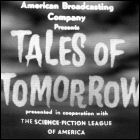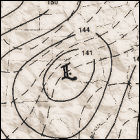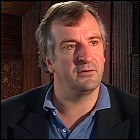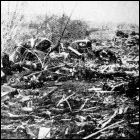 The 18th episode of ABC’s science fiction anthology series, Tales Of Tomorrow, airs on ABC, with each episode’s opening titles proclaiming that the series is produced “in cooperation with the Science-Fiction League of America”, a collective of sci-fi writers including Isaac Asimov and Theodore Sturgeon among its members. This episode, the second part of a two-part adaptation of Jules Verne’s story, stars Thomas Mitchell, Leslie Nielsen, and Brian Keith.
The 18th episode of ABC’s science fiction anthology series, Tales Of Tomorrow, airs on ABC, with each episode’s opening titles proclaiming that the series is produced “in cooperation with the Science-Fiction League of America”, a collective of sci-fi writers including Isaac Asimov and Theodore Sturgeon among its members. This episode, the second part of a two-part adaptation of Jules Verne’s story, stars Thomas Mitchell, Leslie Nielsen, and Brian Keith.
This series is not yet chronicled in the LogBook. You could join theLogBook team and write this guide or support the webmaster’s efforts to expand the site.

 The U.S. Weather Bureau (forerunner of the National Weather Service) inaugurates the Severe Weather Unit at the WBAN (Weather Bureau-Army-Navy) Analysis Center in Washington D.C. Armed with recent research and decades of past research into the formation and behavior of severe thunderstorms and tornadoes, this is the first attempt to offer the military’s growing severe weather prediction capability to the American public. In these early days, before the adoption of specific types of weather watches, the WBAN Severe Weather Unit issues weather bulletins for tornadoes and severe thunderstorms alike; by early 1953, the Severe Weather Unit also issues “outlooks” with more general predictions about the probability of severe storms.
The U.S. Weather Bureau (forerunner of the National Weather Service) inaugurates the Severe Weather Unit at the WBAN (Weather Bureau-Army-Navy) Analysis Center in Washington D.C. Armed with recent research and decades of past research into the formation and behavior of severe thunderstorms and tornadoes, this is the first attempt to offer the military’s growing severe weather prediction capability to the American public. In these early days, before the adoption of specific types of weather watches, the WBAN Severe Weather Unit issues weather bulletins for tornadoes and severe thunderstorms alike; by early 1953, the Severe Weather Unit also issues “outlooks” with more general predictions about the probability of severe storms. Future
Future  The newly formed Weather Bureau-Army-Navy Severe Weather Unit‘s second attempt to warn the public that tornado formation is possible within a specific area strikes paydirt. Again covering a large area including portions of Texas, Oklahoma, Arkansas, and Louisiana, later expanded to include states east of this area, this forerunner of modern tornado watches is right on the money, predicting an outbreak of more than 20 tornadoes in Arkansas, Missouri, Mississippi and Kentucky. Despite the advance notification, the Severe Weather Unit has work to do in educating the public about its bulletins: over 200 deaths still occur as a result of the tornadoes.
The newly formed Weather Bureau-Army-Navy Severe Weather Unit‘s second attempt to warn the public that tornado formation is possible within a specific area strikes paydirt. Again covering a large area including portions of Texas, Oklahoma, Arkansas, and Louisiana, later expanded to include states east of this area, this forerunner of modern tornado watches is right on the money, predicting an outbreak of more than 20 tornadoes in Arkansas, Missouri, Mississippi and Kentucky. Despite the advance notification, the Severe Weather Unit has work to do in educating the public about its bulletins: over 200 deaths still occur as a result of the tornadoes. Collier’s Magazine publishes an extensive pictorial article with text by space pioneers Wernher von Braun and Willy Ley, and illustrations by Chesley Bonestell, positing a future with plane-like spacecraft making routine trips to orbiting space stations. The article suggests that the station could be a reality in ten years and “twice the cost of the atom bomb” if the public shows its support for space exploration. Though spaceplanes and stations are more than a decade away, the Collier’s article is a seminal moment in the space age.
Collier’s Magazine publishes an extensive pictorial article with text by space pioneers Wernher von Braun and Willy Ley, and illustrations by Chesley Bonestell, positing a future with plane-like spacecraft making routine trips to orbiting space stations. The article suggests that the station could be a reality in ten years and “twice the cost of the atom bomb” if the public shows its support for space exploration. Though spaceplanes and stations are more than a decade away, the Collier’s article is a seminal moment in the space age. The
The